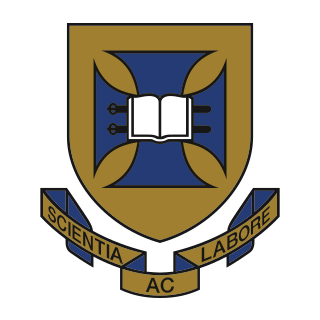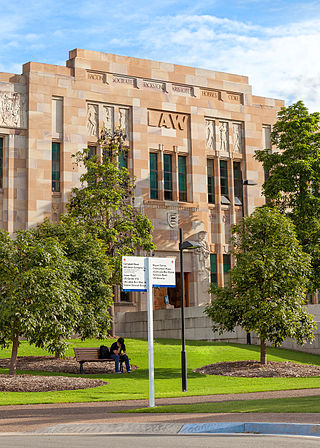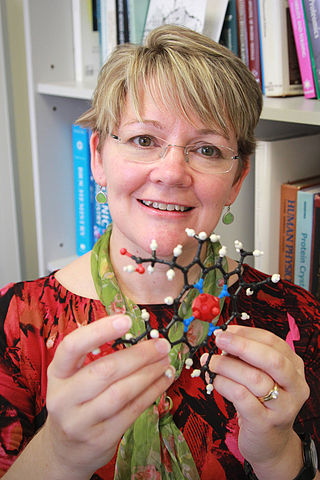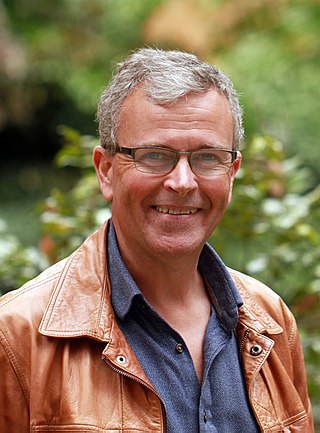Related Research Articles

The University of Queensland is a public research university located primarily in Brisbane, the capital city of the Australian state of Queensland. Founded in 1909 by the Queensland parliament, UQ is one of the six sandstone universities, an informal designation of the oldest university in each state. UQ is also a founding member of edX, Australia's leading Group of Eight and the international research-intensive Association of Pacific Rim Universities.
Keith Joseph Bullock FTSE (1931–2015) was an engineer and academic at the University of Queensland.
A facultative biped is an animal that is capable of walking or running on two legs (bipedal), as a response to exceptional circumstances (facultative), while normally walking or running on four limbs or more. In contrast, obligate bipedalism is where walking or running on two legs is the primary method of locomotion. Facultative bipedalism has been observed in several families of lizards and multiple species of primates, including sifakas, capuchin monkeys, baboons, gibbons, gorillas, bonobos and chimpanzees. Different facultatively bipedal species employ different types of bipedalism corresponding to the varying reasons they have for engaging in facultative bipedalism. In primates, bipedalism is often associated with food gathering and transport. In lizards, it has been debated whether bipedal locomotion is an advantage for speed and energy conservation or whether it is governed solely by the mechanics of the acceleration and lizard's center of mass. Facultative bipedalism is often divided into high-speed (lizards) and low-speed (gibbons), but some species cannot be easily categorized into one of these two. Facultative bipedalism has also been observed in cockroaches and some desert rodents.
Robert Davidson is an Australian composer and lecture in music at the University of Queensland.

Hugh Phillip Possingham, FAA, is the former Queensland Chief Scientist and is best known for his work in conservation biology, applied ecology, and basic ecological theory including population ecology. He is also a professor of mathematics, Professor of Zoology and an ARC Laureate Fellow in the Department of Mathematics and the School of Biological Sciences at The University of Queensland.
Barry Andrew Trimmer is an American scientist, and the Henry Bromfield Pearson Professor of Natural Sciences at Tufts University. In addition to his primary appointment in the Department of Biology he holds secondary appointments in Biomedical Engineering and in Neuroscience at the Tufts Graduate School of Biomedical Science. His research primarily focuses on neurobiology, biomechanics / neuromechanics and soft-bodied locomotion.

The UQ Law School is the law school of the University of Queensland in Brisbane, Australia. Founded in 1936, the school is the sixth-oldest law school in Australia and the oldest and most prestigious in Queensland. Its alumni include six Australian High Court Justices including two Chief Justices of Australia.

Hugh Herr is an American rock climber, engineer, and biophysicist.

Neal M. Ashkanasy is an Australian academic best known for his work on emotions in the workplace. He was honored for his "service to tertiary education, to psychology and to the community." He began his career as a civil engineer but is now a Professor of Management at the University of Queensland Business School.

Bio-inspired robotic locomotion is a fairly new subcategory of bio-inspired design. It is about learning concepts from nature and applying them to the design of real-world engineered systems. More specifically, this field is about making robots that are inspired by biological systems, including Biomimicry. Biomimicry is copying from nature while bio-inspired design is learning from nature and making a mechanism that is simpler and more effective than the system observed in nature. Biomimicry has led to the development of a different branch of robotics called soft robotics. The biological systems have been optimized for specific tasks according to their habitat. However, they are multifunctional and are not designed for only one specific functionality. Bio-inspired robotics is about studying biological systems, and looking for the mechanisms that may solve a problem in the engineering field. The designer should then try to simplify and enhance that mechanism for the specific task of interest. Bio-inspired roboticists are usually interested in biosensors, bioactuators, or biomaterials. Most of the robots have some type of locomotion system. Thus, in this article different modes of animal locomotion and few examples of the corresponding bio-inspired robots are introduced.

Professor Jennifer Louise "Jenny" Martin is an Australian scientist, academic, and was recently the Deputy Vice-Chancellor at the University of Wollongong, in New South Wales. She is a former Director of the Griffith Institute for Drug Discovery at Griffith University. and a former Australian Research Council Laureate Fellow at the Institute for Molecular Bioscience, University of Queensland. Her research expertise lies in the areas of structural biology, protein crystallography, protein interactions and their applications in drug design and discovery.

Jennifer Lea Stow is deputy director (research), NHMRC Principal Research Fellow and head of the Protein Trafficking and Inflammation laboratory at the Institute for Molecular Bioscience (IMB), The University of Queensland, Australia. She was awarded her PhD from Monash University in Melbourne in 1982. As a Fogarty International Fellow, she completed postdoctoral training at Yale University School of Medicine (US) in the Department of Cell Biology. She was then appointed to her first faculty position as an assistant professor at Harvard University in the Renal Unit, Departments of Medicine and Pathology at the Massachusetts General Hospital in Boston. At the end of 1994 she returned to Australia as a Wellcome Trust Senior International Medical Research fellow at The University of Queensland where her work has continued. Stow sits on national and international peer review and scientific committees and advisory boards. She has served as head of IMB's Division of Molecular Cell Biology, and in 2008 she was appointed as deputy director (research).

Elizabeth Nesta "Pat" Marks was an Australian entomologist who described 38 new mosquito species, as well as new species of fruit flies, bugs, cockroaches and ticks. She had a PhD in insect physiology from the University of Cambridge and was a member of the Royal Entomological Society of London.

Heron Island Research Station is a marine research station located on Heron Island, an island within the Great Barrier Reef Marine Park, 80 km from Gladstone, off the coast of Queensland, Australia. It is located at the leeward end of a coral cay on a 10 x 5 kilometre platform reef. Although the island had been used as a turtle cannery in the 1920s, after this was abandoned, it was taken over as a resort in the 1930s, by Captain Christian Poulsen. A number of researchers travelled to the island from the 1930s using the resort facilities. The island became a National Park in 1943, and following the end of World War II, saw the first groups of university students from the University of Queensland arrive. Today the island is divided into three sections - the resort, research station and National Park.
Peter Bordier Høj is a Danish-Australian academic and Vice-Chancellor and President of the University of Adelaide. He has previously served as Vice-Chancellor and President of the University of Queensland and the University of South Australia. Educated at the University of Copenhagen, Høj completed a Bachelor of Science where he majored in biochemistry and chemistry, a Master of Science in biochemistry and genetics and a Doctor of Philosophy in Photosynthesis. He has worked in Denmark and Australia as a researcher and published multiple scientific articles. Høj has also served on a number of different company boards in a variety of roles, including current roles on the boards of CSIRO, Wine Australia and of the Australian Cancer Research Foundation. In 2017 he was elected chair of the Group of Eight, a lobby group that represents Australia’s research-intensive universities. He was the vice-chancellor of the University of Queensland from 2012-2020.

Nicholas Justin Marshall is a British-Australian neuroscientist-ecologist whose research focuses on decoding how animals use color to communicate. He is known for discovering the most complex animal visual system known of any organism. – that of the mantis shrimp, which has 12 color channels.
Daniel Ivan Goldman is an experimental physicist regarded for his research on the biomechanics of animal locomotion within complex materials. Goldman is currently a professor at the Georgia Institute of Technology School of Physics, where he holds a Dunn Family Professorship.
Warwick Bowen is an Australian quantum physicist and nanotechnologist at The University of Queensland. He leads the Quantum Optics Laboratory, is Director of the UQ Precision Sensing Initiative and is one of three Theme Leaders of the Australian Centre for Engineered Quantum Systems.

Brooke E. Flammang is an American biologist at the New Jersey Institute of Technology. She specializes in functional morphology, biomechanics, and bioinspired technology of fishes. Flammang is a discoverer of the radialis muscle in shark tails. She also studies the adhesive disc of the remora, and the walking cavefish, Cryptotora thamicola. Her work has been profiled by major news outlets including The New York Times, The Washington Post, Wired, BBC Radio 5, Discovery Channel, and National Geographic Wild. She was named one of the "best shark scientists to follow" by Scientific American in 2014.
Kerrie Ann Wilson is an Australian environmental scientist and the Pro Vice-Chancellor at Queensland University of Technology (QUT). Wilson is also an affiliated professor in conservation science at the University of Copenhagen, honorary professor at The University of Queensland, a member of the Australian Heritage Council and the Australian Natural Sciences Commissioner for UNESCO.
References
- ↑ "Dr Christofer Clemente". UQ Researchers. University of Queensland. Archived from the original on 9 January 2015. Retrieved 13 October 2014.
- ↑ "Here's $344 million, now make me a lizard robot". news.com.au. 16 November 2011. Retrieved 13 October 2014. (Note that the figure in the headline refers to the total of multiple grants)
- ↑ "Design of a biologically inspired running and climbing robotic lizard (2012–2015)". UQ Researchers. University of Queensland. Retrieved 13 October 2014.
- ↑ "Dr. Christofer J. Clemente". (Subject's personal blog). Retrieved 13 October 2014.
- ↑ "Dr. Christofer Clemente". Insect Biomechanics Workgroup. University of Cambridge. Archived from the original on 19 October 2014. Retrieved 13 October 2014.
- ↑ "Former lab members". Propulsion Physiology Lab. Rowland Institute at Harvard. Retrieved 13 October 2014.
- ↑ "Lizard popping a wheelie". The Museum of Curiosity: Gallery six. qi.com. October 2013. Retrieved 13 October 2014.